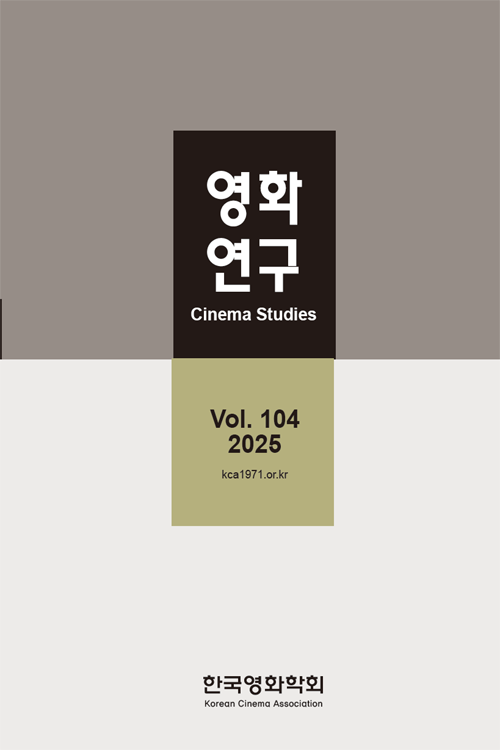- 영문명
- A Study on the Aspects of Film Exchange between North Korea and China in the 1970s
- 발행기관
- 한국영화학회
- 저자명
- 함충범(Chung Beom Ham) 반임정(Lin Jing Pan)
- 간행물 정보
- 『영화연구』제104호, 341~368쪽, 전체 28쪽
- 주제분류
- 예술체육 > 예술일반
- 파일형태
- 발행일자
- 2025.06.30
6,160원
구매일시로부터 72시간 이내에 다운로드 가능합니다.
이 학술논문 정보는 (주)교보문고와 각 발행기관 사이에 저작물 이용 계약이 체결된 것으로, 교보문고를 통해 제공되고 있습니다.

국문 초록
본 논문은 실증적 방법론을 동원하여 1970년대 북한과 중국의 영화 교류의 양상을거시적으로 살펴본 연구의 결과물이다. 동북아시아에 위치한 두 국가에서 영화는 오랫동안 가장 대중적인 선전 도구이자 효과적인 영상 매체로 활용되었는데, 양국이 모두 국내외 정세의 커다란 변화를 겪게 된 1970년대에도 두 국가의 상호 관계 양상이영화 교류에도 직간접적으로 반영되었다. 중국에서 발생한 문화대혁명의 소용돌이 속에서 1960년대 중후반 경색된 북한과 중국의 관계는 ‘데탕트’로 대변되는 국제 질서의 변화와 맞물리며 1970년대 들어 회복세가 가시화되어 갔다. 그러면서 두 국가 간의 영화 교류 역시 이전에 비해 두드러지게 활성화되었다. 1970년대 당시 북한과 중국의 영화 교류는 크게 두 가지 방식으로 이루어졌다. 첫 번째로, 각국의 경축일을 기념하고 양국의 혈맹과 친선·우호의 관계를 확인하기 위해 마련된 영화 상영 행사를, 그리고 각종 영화 및 문화 단체의 상호 방문을 통해서였다. 두 번째로, 상대국 고위급지도자를 대상으로 한 기록 영화의 제작을 통해서였다. 그런데, 횟수 면에서는 전자의경우가 월등히 큰 비중을 차지하였다. 또한 북한 측이 중국 측보다는 비교적 적극적인 모습을 보였으며, 북한 영화나 영화인, 영화 단체의 중국 방문이 빈번한 편이었다. 한편, 1970년대 후반 중국에서는 경제적인 측면에서의 개혁과 개방이 국가 정책의 핵심 노선으로 제시되었다. 이로 인해 북한과 중국의 관계에도 변화의 싹이 트게 되지만, 1980년대까지는 기존의 흐름이 어느 정도 이어진다. 그러면서, 동시기 양국 간 영화 교류에 있어서도 1970년대의 기조가 일정부분 유지된다.
영문 초록
This paper is the result of a study that mainly examined the aspects of film exchange between North Korea and China in the 1970s using empirical methods.In these two countries in Northeast Asia, films have long been the most popular and effective visual propaganda medium. Even in the 1970s, when both countries experienced major changes in domestic and international affairs, the mutual relations between the two countries were directly and indirectly reflected in film exchanges. The relationship between North Korea and China, which had worsened in the mid-1960s due to the Cultural Revolution that occurred in China, began to recover in the 1970s, in line with the change in the international order represented by “détente.” At the same time, film exchanges between the two countries also became more active than before. In the 1970s, film exchanges between North Korea and China took place in three main ways. First, through film screenings held to commemorate each country’s national holidays and to confirm the blood alliance and friendly relations between the two countries. In addition, through mutual visits by various film and cultural organizations. Second, through the production of documentary films for high-ranking leaders of the other country.However, in terms of number of times, the first case accounted for a large proportion. Also, North Korea showed a relatively more active attitude than China, and North Korean films, film makers, and film groups frequently visited China. Meanwhile, in the late 1970s, economic reform and openness were presented as the core lines of national policy in China. As a result, the relationship between North Korea and China also began to change, but the existing trend continued to some extent until the 1980s. At the same time, the 1970s’ keynote was maintained to some extent in the film exchange between the two countries.
목차
1. 들어가며
2. 시대적 배경과 변화상
3. 영화 상영 행사의 마련
4. 영화 단체의 방문과 기록 영화의 제작
5. 나오며
키워드
해당간행물 수록 논문
- 영화는 경찰 부패를 어떻게 재현하는가: 정당화와 침묵의 서사 분석
- 알모도바르의 영화 <룸넥스트도어 The Room Next Door>를 통해 본 죽음의 사회적 드라마
- 안성기의 스타 페르소나 연구: 1980년대 영화를 중심으로
- 미카엘 하네케 <피아니스트>에 나타난 사디즘/마조히즘의 시선 연구
-
욕망의 거울과 신체의 변형: 영화
에 나타난 정신분석적 해석 - <21세기에서 무사히 탈출하기>의 장르 전략과 이데올로기 모순
- 1970년대 북한과 중국의 영화 교류 양상 연구
- 시네마틱 VR에서의 연출 전략 변화 고찰: <기억을 만나다> 제작사례를 중심으로
- 영화 <컨택트>의 철학적 탐구: 언어, 시간, 자유의지
- 한국 스포츠 영화의 발전과 사회문화적 의미에 관한 연구
- 이카루스 신화의 재서사화 - OTT 드라마의 관계적 서사와 캐릭터 원형 변주 연구: <중증외상센터>와 <하이퍼나이프>를 중심으로
- <애마부인>이 등장하기까지: 영화 풍속 검열의 변동 요인 분석, 1979∼1982
참고문헌
관련논문
예술체육 > 예술일반분야 BEST
- 생성형 AI 도구와 디자이너의 협업 프로세스 개발 - 이미지를 통한 아이디어 확산에서 고해상도 렌더링까지
- 디자인 전공 교과목에서의 생성형 AI 도구 활용 사례 연구
- 커피 프랜차이즈 기업의 캐릭터 콜라보레이션 전략 연구 - 큐렌들리 마케팅을 중심으로
예술체육 > 예술일반분야 NEW
- TV 드라마 <동백꽃 필 무렵>의 성공 요인 분석-대본과 그 장르를 중심으로 -
- 소통을 위한 영화의 형식적 표현 연구-영화 <증인>을 중심으로 -
- 영화 <서치>의 연출 분석-파운드 푸티지와 전통적인 장르의 융합을 중심으로 -
최근 이용한 논문
교보eBook 첫 방문을 환영 합니다!

신규가입 혜택 지급이 완료 되었습니다.
바로 사용 가능한 교보e캐시 1,000원 (유효기간 7일)
지금 바로 교보eBook의 다양한 콘텐츠를 이용해 보세요!



